Inhibiting inflammation with milk oligosaccharides
Morrow; Ardythe L. ; et al.
U.S. patent application number 15/998799 was filed with the patent office on 2019-04-04 for inhibiting inflammation with milk oligosaccharides. This patent application is currently assigned to Children's Hospital Medical Center. The applicant listed for this patent is Children's Hospital Medical Center, The General Hospital Corporation d/b/a Massachusetts General Hospital, Instituto Nacional de Ciencias Medicas Y Nutricion, The General Hospital Corporation d/b/a Massachusetts General Hospital. Invention is credited to Ardythe L. Morrow, David S. Newburg, Guillermo M. Ruiz-Palacios.
| Application Number | 20190099435 15/998799 |
| Document ID | / |
| Family ID | 43429494 |
| Filed Date | 2019-04-04 |
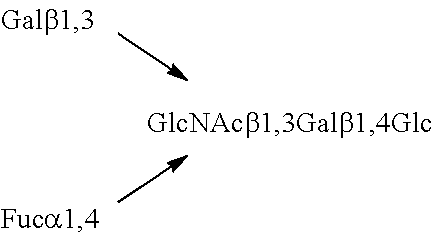
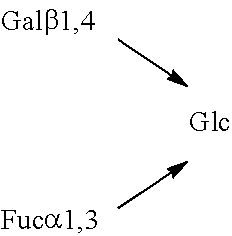




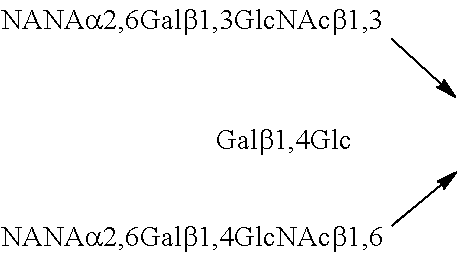

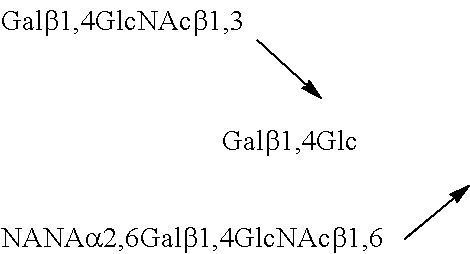


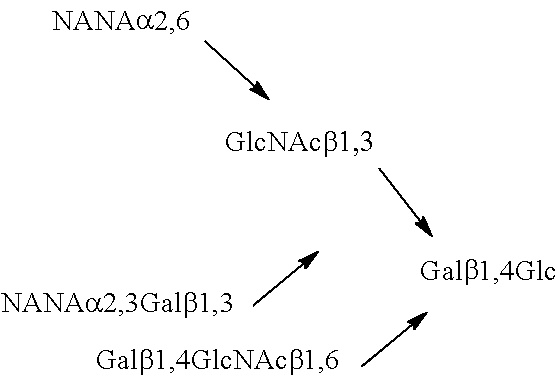
View All Diagrams
| United States Patent Application | 20190099435 |
| Kind Code | A1 |
| Morrow; Ardythe L. ; et al. | April 4, 2019 |
Inhibiting inflammation with milk oligosaccharides
Abstract
A method of inhibiting inflammation with milk oligosaccharides or glycoconjugates containing the oligosaccharides.
| Inventors: | Morrow; Ardythe L.; (Cincinnati, OH) ; Newburg; David S.; (Newtonville, MA) ; Ruiz-Palacios; Guillermo M.; (Mexico City, MX) | ||||||||||
| Applicant: |
|
||||||||||
|---|---|---|---|---|---|---|---|---|---|---|---|
| Assignee: | Children's Hospital Medical
Center Cincinnati OH The General Hospital Corporation d/b/a Massachusetts General Hospital Boston MA Instituto Nacional de Ciencias Medicas Y Nutricion Mexico |
||||||||||
| Family ID: | 43429494 | ||||||||||
| Appl. No.: | 15/998799 | ||||||||||
| Filed: | August 16, 2018 |
Related U.S. Patent Documents
| Application Number | Filing Date | Patent Number | ||
|---|---|---|---|---|
| 14700232 | Apr 30, 2015 | 10098903 | ||
| 15998799 | ||||
| 13382323 | Mar 26, 2012 | 9034847 | ||
| PCT/US2010/040895 | Jul 2, 2010 | |||
| 14700232 | ||||
| 61223145 | Jul 6, 2009 | |||
| Current U.S. Class: | 1/1 |
| Current CPC Class: | A61P 1/16 20180101; A61K 35/20 20130101; A61K 31/702 20130101; A61P 1/04 20180101; A61K 47/62 20170801; A61K 47/61 20170801; A61P 1/12 20180101; A61P 1/00 20180101; A61K 31/7016 20130101; A61P 29/00 20180101; A61K 47/50 20170801; A61P 31/00 20180101; A61P 31/04 20180101 |
| International Class: | A61K 31/7016 20060101 A61K031/7016; A61K 47/62 20170101 A61K047/62; A61K 31/702 20060101 A61K031/702 |
Goverment Interests
GOVERNMENT SUPPORT
[0002] This invention was made with government support under HD013021 awarded by the National Institutes of Health. The government has certain rights in the invention.
Claims
1. A method of inhibiting inflammation, comprising administering to a subject in need thereof an effective amount of a composition containing at least a milk-derived oligosaccharide or a glycoconjugate containing the oligosaccharide, the oligosaccharide including a first sugar unit and a second sugar unit, wherein the first sugar unit, located at a first non-reducing end, is fucose, galactose, mannose, or sialic acid and the second sugar unit, linked to the first sugar unit, is galactose, glucose, mannose, or N-acetylglucosamine.
2. The method of claim 1, wherein the first sugar unit is fucose.
3. The method of claim 2, wherein the oligosaccharide is 2'-fucosyllactose, lacto-N-fucopentaose I, or a variant thereof, which is identical to the oligosaccharide except that the reducing end is N-acetylglucosamine instead of glucose.
4. The method of claim 1, wherein the oligosaccharide includes a second non-reducing end.
5. The method of claim 4, wherein the sugar unit at the second non-reducing end is fucose.
6. The method of claim 5, wherein the oligosaccharide is lacto-N-difucohexaose I, lactodifucotetraose, or a variant thereof, which is identical to the oligosaccharide except that the reducing end is N-acetylglucosamine instead of glucose.
7. The method of claim 4, wherein the sugar unit at the second non-reducing end is galactose.
8. The method of claim 7, wherein the oligosaccharide is lacto-N-fucopentaose II, 3'-fucosyllactose, lacto-N-fucopentaose III, or a variant thereof, which is identical to the oligosaccharide except that the reducing end is N-acetylglucosamine instead of glucose.
9. The method of claim 4, wherein the sugar unit at the second non-reducing end is sialic acid.
10. The method of claim 9, wherein the oligosaccharide is 3'-sialyl-3-fucosyllactose, disialomonofucosyllacto-N-neohexaose, monofucosylmonosialyllacto-N-octaose, sialyllacto-N-fucohexaose II, disialyllacto-N-fucopentose II, monofucosyldisialyllacto-N-tetraose, or a variant thereof, which is identical to the oligosaccharide except that the reducing end is N-acetylglucosamine instead of glucose.
11. The method of claim 1, wherein the first sugar unit is sialic acid.
12. The method of claim 11, wherein the oligosaccharide is 3'-sialyllactose, 6'-sialyllactose, sialyllacto-N-neotetraose c, sialyllacto-N-tetraose a, or a variant thereof, which is identical to the oligosaccharide except that the reducing end is N-acetylglucosamine instead of glucose.
13. The method of claim 11, wherein the oligosaccharide includes a second non-reducing end.
14. The method of claim 13, wherein the sugar unit at the second non-reducing end is galactose.
15. The method of claim 14, wherein the oligosaccharide is monosialyllacto-N-hexaose, monosialyllacto-N-neohexaose I, monosialyllacto-N-neohexaose II, sialyllacto-N-tetraose b, or a variant thereof, which is identical to the oligosaccharide except that the reducing end is N-acetylglucosamine instead of glucose.
16. The method of claim 13, wherein the sugar unit at the second non-reducing end is sialic acid.
17. The method of claim 16, wherein the oligosaccharide is disialyllacto-N-hexaose I, disialyllacto-N-neohexaose, disialyllacto-N-tetraose, disialyllacto-N-hexaose II, disialyllacto-N-hexaose I, or a variant thereof, which is identical to the oligosaccharide except that the reducing end is N-acetylglucosamine instead of glucose.
18. The method of claim 1, wherein in the glycoconjugate, the oligosaccharide is conjugated with a carbohydrate, a lipid, or a peptide.
19. The method of claim 1, wherein the subject suffers from or is at risk for an inflammatory disease of the digestive tract.
20. The method of claim 19, wherein the inflammatory disease of the digestive tract is selected from the group consisting of oesophagitis, gastroenteritis, colitis, cholangitis, and appendicitis.
21.-31. (canceled)
Description
CROSS-REFERENCE TO RELATED APPLICATIONS
[0001] This application is a continuation of U.S. patent application Ser. No. 14/700,232, filed Apr. 30, 2015, which is a continuation of U.S. patent application Ser. No. 13/382,323, filed Mar. 26, 2012, now U.S. Pat. No. 9,034,847, which is national stage filing under 35 U.S.C. 371 of International Patent Application Serial No. PCT/US2010/040895, filed Jul. 2, 2010, which claims the benefit of U.S. Provisional Application No. 61/223,145 filed on Jul. 6, 2009, the content of each of which is hereby incorporated by reference in their entirety.
BACKGROUND OF THE INVENTION
[0003] Various components in human milk, e.g., milk immunoglobulins, leukocytes, oligosaccharides, and glycoconjugates, protect infants against infectious diseases. Human milk is thus considered a natural efficacious "nutriceutical," i.e., a model food that conveys immunologic benefits.
[0004] Human milk has also been found to reduce the risk of developing inflammatory enteric diseases in infants. This anti-inflammation activity has been attributed to the leukocytes, cytokines, and antioxidants in human milk. See Buescher, Adv Exp Med Biol. 501:207-22 (2001).
SUMMARY OF THE INVENTION
[0005] The present invention is based on an unexpected discovery that oligosaccharides in human milk inhibit inflammation.
[0006] Accordingly, one aspect of this invention features a method of inhibiting inflammation by administering to a subject in need thereof an effective amount of a composition containing one or more milk-derived oligosacchairdes or one or more glycoconjugates containing the oligosaccharide(s). A milk-derived oligosaccharide contains a first sugar unit (i.e., fucose, galactose, mannose, or sialic acid), which is located at a non-reducing end of the oligosaccharide, and a second sugar unit (i.e., galactose, glucose, mannose, or N-acetylglucosamine), which is directly linked to the first sugar unit. In one example, the oligosaccharide is a linear molecule having one non-reducing end and one reducing end. In another example, it is a branched molecule having multiple non-reducing ends and one reducing end. When the oligosaccharide has two non-reducing ends, the sugar unit at one non-reducing end can be fucose and that at the other non-reducing end can be fucose, galactose, or sialic acid, or alternatively, the sugar unit at one non-reducing end is sialic acid and that at the other non-reducing end is galactose or sialic acid. The sugar unit at the reducing end can be a glucose or an N-acctylglucosamine.
[0007] The glycoconjugate(s) used in the method described above can include one or more of the milk-derived oligosaccharide(s) also described above conjugated with a lipid, a peptide, a polypeptide, or a carbohydrate.
[0008] Another aspect of this invention features a method of inhibiting inflammation with oligosaccharides isolated from milk, which can be derived from a human, a bovid (e.g., a cow, a goat, or a sheep), or another mammal (e.g. a horse or a camel). The oligosaccharides can be prepared by first removing fat and protein from the milk before its isolation via conventional methods. In one example, after removal of fat and protein, the milk is loaded onto a carbon column and the oligosaccharides adsorbed onto the column are eluted with an alcohol solution (e.g., a 50% aqueous ethanol solution).
[0009] The method of this invention can be applied to a subject, e.g., a human or a non-human mammal, who is suffering from or at risk for developing an inflammatory disease, such as a disease of the digestive tract. Examples include oesophagitis, gastroenteritis, colitis, cholangitis, appendicitis, inflammatory bowel diseases (i.e., ulcerative colitis, necrotizing enterocolitis, and Crohn's disease), or irritable bowel syndrome.
[0010] Also within the scope of this invention is use of one or more milk-derived oligosaccharides or one or more glycoconjugates containing the oligosaccharide(s) for inhibiting inflammation and for the manufacture of a medicament for treating inflammatory diseases.
[0011] The details of one or more embodiments of the invention are set forth in the description below. Other features or advantages of the present invention will be apparent from the following drawings and detailed description of an example, and also from the appended claims.
BRIEF DESCRIPTION OF THE DRAWINGS
[0012] The drawings are first described.
[0013] FIG. 1 is a chart showing that human milk oligosaccharides inhibit TNF-.alpha. induced IL-8 production by T84 enterocytes.
[0014] FIG. 2 is a chart showing that human milk oligosaccharides inhibit TNF-.alpha. induced monocyte chemoattractant protein-1 production by human intestinal mucosa.
[0015] FIG. 3 is a chart showing that flagelin, polyinosinic-polycytidilic double-stranded RNA, or IL-1.beta. induces IL-8 production in organ culture of immature human intestinal mucosa and human milk oligosaccharides inhibit this induced IL-8 production.
DETAILED DESCRIPTION OF THE INVENTION
[0016] Disclosed herein is a method of inhibiting inflammation with one or more milk-derived oligosaccharides or one or more glycoconjugates containing the oligosaccharides.
[0017] A milk-derived oligosaccharide, i.e., having at least three sugar units, is either a naturally-occurring oligosaccharide found in milk, a fragment of the naturally-occurring oligosaccharide, or a variant thereof that contains a modified (e.g., sulfated, acetylated, or phosphorylated) sugar unit as compared to its natural counterpart. This oligosaccharide includes a non-reducing end motif S.sub.1S.sub.2, in which S.sub.1 is fucose, galactose, mannose, or sialic acid (N-acetyl or N-glycolyl) and S.sub.2 is galactose, glucose, mannose, or N-acetylglucosamine. S.sub.1 is linked to S.sub.2 via an .alpha. or .beta. glycosidic bond. When S.sub.1 is fucose, the glycosidic bond between S.sub.1 and S.sub.2 preferably is an .alpha.1,2, an .alpha.1,3, or an .alpha.1,4 bond. When it is sialic acid, the glycosidic bond preferably is an .alpha.2,3 or an .alpha.2,6 bond.
[0018] Milk-derived oligosaccharides and glycolconjugates containing such oligosaccharides are well known in the art. See, e.g., U.S. Patent Application 61/168,674 and WO2005/055944. The following tables list exemplary oligosaccharides that naturally occur in human milk:
TABLE-US-00001 TABLE 1 Fucosyl oligosaccharides 2'FL 2-Fucosyllactose Fuc.alpha.1,2Gal.beta.1,4Glc LNF-I Lacto-N-fucopentaose I Fuc.alpha.1,2Gal.beta.1,3GlcNAc.beta.1,3Gal.beta.1,4Glc LNF-II Lacto-N-fucopentaose II ##STR00001## 3'FL 3-Fucosyllactose ##STR00002## LNF-III Lacto-N-fucopentaose III ##STR00003## LDFH-I Lacto-N-difucohexaose 1 ##STR00004## LDFT Lactodifucotetraose ##STR00005##
TABLE-US-00002 TABLE 2 Nonfucosylated, nonsialylated oligosaccharides LNT Lacto-N-tetraose Gal.beta.1,3GlcNAc.beta.1,3Gal.beta.1,4Glc LNneoT Lacto-N-neotetraose Gal.beta.1,4GlcNAc.beta.1,3Gal.beta.1,4Glc
TABLE-US-00003 TABLE 3 Sialyl milk oligosaccharide structures 3'-SL 3'-Sialyllactose NANA.alpha.2,3Gal.beta.1,4Glc 6'-SL 6'-Sialyllactose NANA.alpha.2,6Gal.beta.1,4Glc SLNT-c Sialyllacto-N-neotetraose c NANA.alpha.2,6Gal.beta.1,4GlcNAc.beta.1,3Gal.beta.1,4Glc MSLNH Monosialyllacto-N-hexaose ##STR00006## DSLNH-I Disialyllacto-N-hexaose I ##STR00007## MSLNnH-I Monosialyllacto-N-neohexaose I ##STR00008## SLNnH-II Monosialyllacto-N-neohexaose II ##STR00009## DSLNnH Disialyllacto-N-neohexaose ##STR00010## DSLNT Disialyllacto-N-tetraose ##STR00011## DSLNH-II Disialyllacto-N-hexaose II ##STR00012## SLNT-a Sialyllacto-N-tetraose a NANA.alpha.2,3Gal.beta.1,3GlcNAc.beta.1,3 Gal.beta.1,4Glc DSLNH-I Disialyllacto-N-hexaose I ##STR00013## SLNT-b Sialyllacto-N-tetraose b ##STR00014##
TABLE-US-00004 TABLE 4 Sialyl fucosyl oligosaccharidcs 3'-S-3FL 3'-Sialyl-3-fucosyllactose ##STR00015## DSFLNH Disialomonofucosyllacto-N-neohexaose ##STR00016## MFMSLNO Monofucosylmonosialyllacto-N-octaose (sialyl Lea) ##STR00017## SLNFH-II Sialyllacto-N-fucohexaose II ##STR00018## DSLNFP-II Disialyllacto-N-fucopentaose II ##STR00019## MFDLNT Monofucosyldisialyllacto-N-tetraose ##STR00020##
[0019] The milk-derived oligosaccharides described herein can be prepared by conventional methods, e.g., synthesized chemically, purified from milk, or produced in a microorganism. See WO2005/055944. Below is an example of isolating oligosaccharides from milk. Milk is first defatted by centrifugation to produce skimmed milk. The skimmed milk is then mixed with an organic solvent, such as acetone (e.g., 50% aqueous acetone) and ethanol (e.g., 67% aqueous ethanol), to precipitate milk proteins. Upon centrifugation, the supernatant is collected and subjected to chromatography. Oligosaccharide-containing fractions are collected and pooled. If necessary, the oligosaccharides thus prepared can be concentrated by conventional methods, e.g., dialysis or freeze-drying.
[0020] Milk oligosaccharides can also be isolated from skimmed milk by passing the skimmed milk through a 30,000 MWCO ultrafiltration membrane, collecting the diffusate, passing the diffusate through a 500 MWCO ultrafilter, and collecting the retentate, which contains milk oligosaccharides.
[0021] The glycoconjugates described herein, containing one or more milk-derived oligosaccharides, can be chemically synthesized by conjugating the oligosaccharide(s) to a backbone molecule (e.g., a carbohydrate, a lipid, a nucleic acid, or a peptide) directly or via a linker. As used herein, "glycoconjugate" refers to a complex containing a sugar moiety associated with a backbone moiety. The sugar and the backbone moieties can be associated via a covalent or noncovalent bond, or via other forms of association, such as entrapment (e.g., of one moiety on or within the other, or of either or both entities on or within a third moiety). The glycoconjugate described herein can contain one type of milk-derived oligosaccharide (i.e., one or more copies of a milk-derived oligosaccharide attached to one backbone molecule). Alternatively, the glycoconjugate contains multiple types of milk-derived oligosaccharides. In one example, the milk-derived oligosaccharide (e.g., lacto-N-fucopentaose I, 2-fucosyllactose, lacto-N-difucohexaose I, lactodifucotetraose, or an acetylated variant thereof) is covalently linked via its reducing end sugar unit to a lipid, a protein, a nucleic acid, or a polysaccharide. Preferably, the reducing end sugar unit is N-acetylglucosamine.
[0022] Peptide backbones suitable for making the glycoconjugate described above include those having multiple glycosylation sites (e.g., asparagine, lysine, serine, or threonine residue) and low allergenic potential. Examples include, but are not limited to, amylase, bile salt-stimulated lipase, casein, folate-binding protein, globulin, gluten, haptocorrin, lactalbumin, lactoferrin, lactoperoxidase, lipoprotein lipase, lysozyme, mucin, ovalbumin, and serum albumin.
[0023] Typically, a milk-derived oligosaccharide can be covalently attached to a serine or threonine residue via an O-linkage or attached to an asparagine residue via an N-linkage. To form these linkages, the sugar unit at the reducing end of the oligosaccharide is preferably an acetylated sugar unit, e.g., N-acetylgalactosamine, N-acetylglucosamine, and N-acetylmannosamine. An oligosaccharide can be attached to a peptide (e.g., a protein) using standard methods. See, e.g., McBroom et al., Complex Carbohydrates, Part B, 28:212-219, 1972; Yariv et al., Biochem J., 85:383-388, 1962; Rosenfeld et al., Carbohydr. Res., 46:155-158, 1976; and Pazur, Adv. Carbohydr. Chem, Biochem., 39:405-447, 1981.
[0024] In one example, a milk-derived oligosaccharide is linked to a backbone molecule via a linker. Exemplary linkers are described in WO2005/055944. The oligosaccharide can be bonded to a linker by an enzymatic reaction, e.g., a glycosyltransferase reaction. A number of glycosyltransferases, including fucosyltransferases, galactosyltransferases, glucosyltransferases, mannosyltransferases, galactosaminyltransferases, sialyltransferases and N-acetylglucosaminyltransferases, can be used to make the glycoconjugate described herein. More details about these glycosyltransferases can be found in U.S. Pat. Nos. 6,291,219; 6,270,987; 6,238,894; 6,204,431; 6,143,868; 6,087,143; 6,054,309; 6,027,928; 6,025,174; 6,025,173; 5,955,282; 5,945,322; 5,922,540; 5,892,070; 5,876,714; 5,874,261; 5,871,983; 5,861,293; 5,859,334; 5,858,752; 5,856,159; and 5,545,553.
[0025] Alternatively, the glycoconjugates described herein can be purified from milk by conventional methods e.g., by passing through ultrafiltration membranes, by precipitation in non-polar solvents, or through partition between immiscible solvents.
[0026] One or more of the above-described milk oligosaccharides or glycoconjugates can be mixed with a pharmaceutically acceptable carrier to form a pharmaceutical composition. The carrier in the pharmaceutical composition must be "acceptable" in the sense of being compatible with the active ingredient of the formulation (and preferably, capable of stabilizing it) and not deleterious to the subject to be treated. For example, solubilizing agents such as cyclodextrins, which form more soluble complexes with the oligosaccharides/glycoconjugates, or more solubilizing agents, can be utilized as pharmaceutical carriers for delivery of the oligosccharides/glyconjugates. Examples of other carriers include colloidal silicon dioxide, magnesium stearate, sodium lauryl sulfate, and D&C Yellow #10.
[0027] Alternatively, the oligoscchairdes/glycoconjugates can also be formulated as food produces or food supplements following methods well known in the food industry. In one example, they arc components of infant formulas.
[0028] The oligosaccharides and glycoconjugates are effective in inhibiting inflammation and treating inflammation-associated diseases (i.e., inflammatory diseases). Inflammation is reaction of living tissue (e.g., heat, redness, swelling, or pain) in response to injury or infection. Exemplary inflammation-associated diseases, characterized by a local or systemic, acute or chronic inflammation, include inflammatory retinopathy (e.g., diabetic retinopathy), dermatoses (e.g., dermatitis, eczema, atopic dermatitis, allergic contact dermatitis, urticaria, necrotizing vasculitis, cutaneous vasculitis, hypersensitivity vasculitis, eosinophilic myositis, polymyositis, dermatomyositis, and eosinophilic fasciitis), hypersensitivity lung diseases (e.g., hypersensitivity pneumonitis, eosinophilic pneumonia, delayed-type hypersensitivity, interstitial lung disease or ILD, idiopathic pulmonary fibrosis, and ILD associated with as rheumatoid arthritis), asthma, and allergic rhinitis. In addition to treating the above-listed inflammatory diseases, the method of this invention is particularly effective in treating inflammatory disease of the digestive tract, including oesophatigis (i.e., inflammation of the oesophagus, such as oesophageal ulcer), gastroenteritis (i.e., inflammation of the mucous membranes of the stomach and intestine, such as gastritis, duodenal ulcer, ileitis, or enterocolitis), colitis (i.e., inflammation of the colon, such as diverticulitis), cholangitis (i.e., inflammation of the bile duct), and appendicitis (i.e., inflammation of the appendix). Inflammatory disease of the digestive tract also includes inflammatory bowel diseases (e.g., Crohn's disease and ulcerative colitis) and irritable bowel syndrome.
[0029] The term "treating" as used herein refers to the application or administration of a composition including one or more active agents to a subject, who has an inflammatory disease, a symptom of the inflammatory disease, or a predisposition toward the inflammatory disease, with the purpose to cure, heal, alleviate, relieve, alter, remedy, ameliorate, improve, or affect the disease, the symptoms of the disease, or the predisposition toward the disease.
[0030] To practice the method of this invention, an effective amount of the above-described pharmaceutical composition can be administered to a subject (e.g., a human infant or elderly) orally, parenterally, by inhalation spray, topically, rectally, nasally, buccally, vaginally or via an implanted reservoir. The term "parenteral" as used herein includes subcutaneous, intracutaneous, intravenous, intramuscular, intraarticular, intraarterial, intrasynovial, intrasternal, intrathecal, intralesional, and intracranial injection or infusion techniques. "An effective amount" as used herein refers to the amount of each active agent required to confer therapeutic effect on the subject, either alone or in combination with one or more other active agents. Effective amounts vary, as recognized by those skilled in the art, depending on route of administration, excipient usage, and co-usage with other active agents.
[0031] A sterile injectable composition, e.g., a sterile injectable aqueous or oleaginous suspension, can be formulated according to techniques known in the art using suitable dispersing or wetting agents (such as Tween 80) and suspending agents. The sterile injectable preparation can also be a sterile injectable solution or suspension in a non-toxic as parenterally acceptable diluent or solvent, for example, as a solution in 1,3-butanediol. Among the acceptable vehicles and solvents that can be employed are mannitol, water, Ringer's solution and isotonic sodium chloride solution. In addition, sterile, fixed oils are conventionally employed as a solvent or suspending medium (e.g., synthetic mono- or diglycerides). Fatty acids, such as oleic acid and its glyceride derivatives are useful in the preparation of injectables, as are natural pharmaceutically-acceptable oils, such as olive oil or castor oil, especially in their polyoxyethylated versions. These oil solutions or suspensions can also contain a long-chain alcohol diluent or dispersant, or carboxymethyl cellulose or similar dispersing agents. Other commonly used surfactants such as Tweens or Spans or other similar emulsifying agents or bioavailability enhancers which are commonly used in the manufacture of pharmaceutically acceptable solid, liquid, or other dosage forms can also be used for the purposes of formulation.
[0032] A composition for oral administration can be any orally acceptable dosage form including, but not limited to, capsules, tablets, emulsions and aqueous suspensions, dispersions and solutions. In the case of tablets for oral use, carriers which are commonly used include lactose and corn starch. Lubricating agents, such as magnesium stearate, are also typically added. For oral administration in a capsule form, useful diluents include lactose and dried corn starch. When aqueous suspensions or emulsions are administered orally, the active ingredient can be suspended or dissolved in an oily phase combined with emulsifying or suspending agents. If desired, certain sweetening, flavoring, or coloring agents can be added. A nasal aerosol or inhalation composition can be prepared according to techniques well known in the art of pharmaceutical formulation.
[0033] Suitable in vitro and in vivo assays can be used to preliminarily evaluate the anti-inflammation activity of a particular milk oligosaccharide or a combination of various milk oligosaccharides. For example, the oligosaccharide(s) can be tested in vitro for its ability of inhibiting secretion of pro-inflammatory cytokines (e.g., IL-1, IL-6, TNF-alpha GM-CSF, IL-8, and IL-12). The anti-inflammation activity can further be confirmed in an animal model (e.g., a mouse model). Based on the results, an appropriate dosage range and administration route can also be determined.
[0034] Without further elaboration, it is believed that one skilled in the art can, based on the above description, utilize the present invention to its fullest extent. The following specific example is therefore to be construed as merely illustrative, and not limitative of the remainder of the disclosure in any way whatsoever. All publications cited herein are incorporated by reference.
Use of Human Milk Oligosaccharides for Inhibiting Intestinal Inflammation
Preparation of Human Milk Oligosaccharides
[0035] An oligosaccharide fraction was isolated from human milk following the method described in Chaturvedi et al., Anal. Biochem. 251(1):89-97, 1997. Briefly, pooled human milk was first defatted and then ethanol was added to precipitate proteins. The resultant solution was loaded onto a carbon column, which adsorbs oligosaccharides. The column was washed with 5% ethanol and the adsorbed oligosaccharides were eluted with 60% ethanol to produce a fraction containing human milk oligosaccharides ("HMOS").
HMOS Inhibit IL-8 Secretion in TNF-Treated T84 Cells
[0036] T84 cells, used routinely for studying neonatal epithelial inflammation, were cultured in 24-well Falcon organ culture dishes at 37.degree. C. with 95% O.sub.2 and 5% CO.sub.2 in DMEM/F12 medium supplemented with FBS (5%), Hepes buffer, NaOH, penicillin and streptomycin. These cells were treated with (i) saline as a negative control, (ii) TNF-.alpha. (10 ng/mL) as a positive control, (iii) HMOS (5 g/L), and (iv) TNF-.alpha. (10 ng/mL) and HMOS (5 g/L). After 16 hours, the concentration of IL-8 in each culture supernatant was measured by ELISA. The results thus obtained were standardized to the cell numbers (i.e., divided by the total cell protein contents of the corresponding cell cultures).
[0037] As shown in FIG. 1, the TNF-induced IL-8 production was significantly reduced in HMOS-treated T84 cells, indicating that HMOS exhibited anti-inflammatory activity.
HMOS Inhibit Monocyte Chemoattractant Protein-1(MCP-1) Secretion in Human Intestinal
Mucosa
[0038] Human small intestine mucosa samples from 14 wk abortuses were incubated in 24-well Falcon organ culture plates with CMRL 1066 medium supplemented with FBS (5%), glucose (5 g/L), tricine buffer (20 mM, pH 7.4), hydrocortisone hemisuccinate (0.5 .mu.g/L), .beta.-retinyl acetate (1 mg/L), penicillin and streptomycin in 5% CO.sub.2 at 37.degree. C. The mucosa samples were treated with (i) saline as a negative control, (ii) TNF-.alpha. (10 ng/mL) as a positive control, (iii) HMOS (5 g/L), and (iv) TNF-.alpha. (10 ng/mL) and HMOS (5 g/L). After 16 hours, the concentration of MCP-1, a pro-inflammatory chemokine, was measured in each culture supernatant by ELISA. The results thus obtained were standized to cell numbers as described above.
[0039] The data obtained from this study, shown indicate that in the presence of TNF-.alpha., human intestinal mucosa secreted a high level of MCP-1, a measure of inflammation and this TNF-.alpha. induced MCP-1 production was attenuated by HMOS. See FIG. 2.
Inhibition of IL-8 Secretion in Organ Culture of Immature Human Intestinal Mucosa
[0040] Human small intestine samples from 22 wk abortuses were incubated in 24-well plates with the modified CMRL media described above in 5% CO.sub.2 at 37.degree. C. The samples were treated with IL-1.beta. (10 ng/mL), flagellin (1 mg/mL), polyinosinic-polycytidilic double stranded RNA (PIC; 10 ng/mL), or PBS (as a negative control) in the absence or presence of 5 mg/mL HMOS for 18 h. Levels of IL-8 secretion in the culture supernatants were measured using a ELISA kit (R & D Systems) in duplicate, with detection at 450 nm on a versa max plate reader (Molecular Devices, CA, USA). Each OD.sub.450 value was normalized to the total protein amount of the corresponding organ culture.
[0041] Flagelin, polyinosinic-polycytidilic double stranded RNA, and IL-1.beta. all induced a pro-inflammatory response, as evidenced by secretion of IL-8. See FIG. 3. This pro-inflammatory response was significantly attenuated by HMOS.
[0042] Take together, the results shown above indicate that milk oligosaccharides are effective in inhibiting inflammation.
Other Embodiments
[0043] All of the features disclosed in this specification may be combined in any combination. Each feature disclosed in this specification may be replaced by an alternative feature serving the same, equivalent, or similar purpose. Thus, unless expressly stated otherwise, each feature disclosed is only an example of a generic series of equivalent or similar features.
[0044] From the above description, one skilled in the art can easily ascertain the essential characteristics of the present invention, and without departing from the spirit and scope thereof, can make various changes and modifications of the invention to adapt it to various usages and conditions. Thus, other embodiments are also within the claims.
* * * * *
















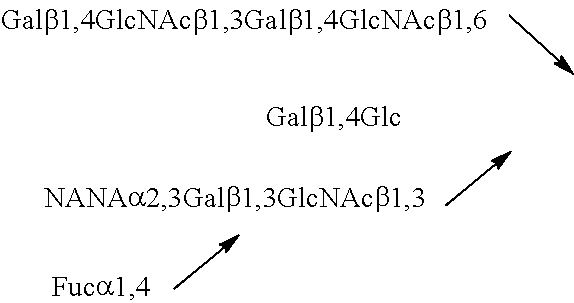

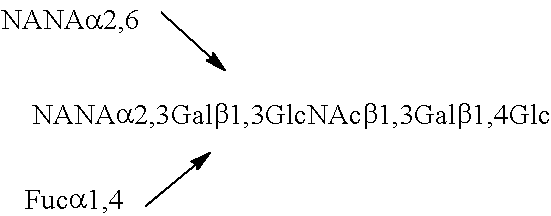

D00001

D00002

D00003
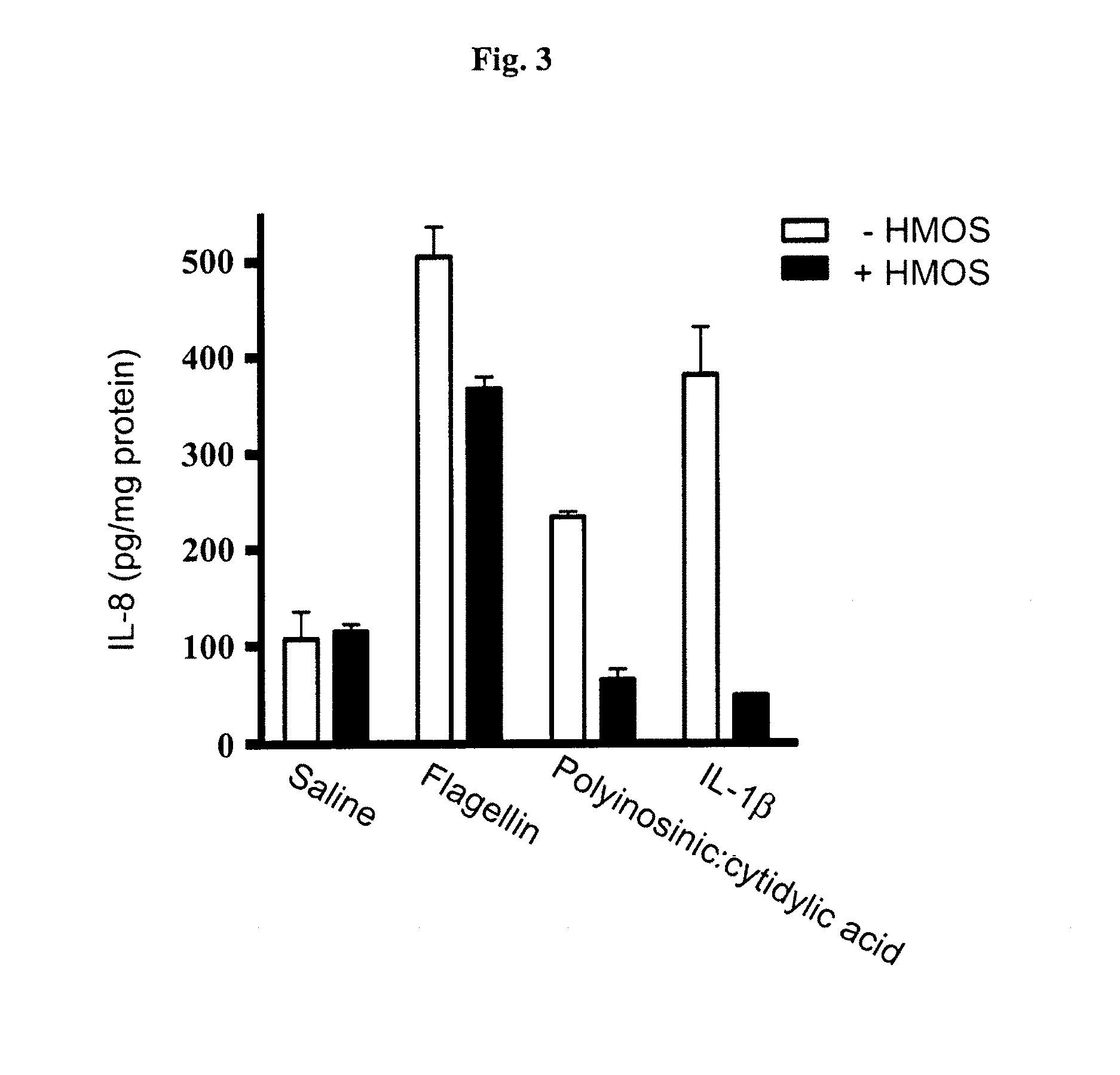
XML
uspto.report is an independent third-party trademark research tool that is not affiliated, endorsed, or sponsored by the United States Patent and Trademark Office (USPTO) or any other governmental organization. The information provided by uspto.report is based on publicly available data at the time of writing and is intended for informational purposes only.
While we strive to provide accurate and up-to-date information, we do not guarantee the accuracy, completeness, reliability, or suitability of the information displayed on this site. The use of this site is at your own risk. Any reliance you place on such information is therefore strictly at your own risk.
All official trademark data, including owner information, should be verified by visiting the official USPTO website at www.uspto.gov. This site is not intended to replace professional legal advice and should not be used as a substitute for consulting with a legal professional who is knowledgeable about trademark law.